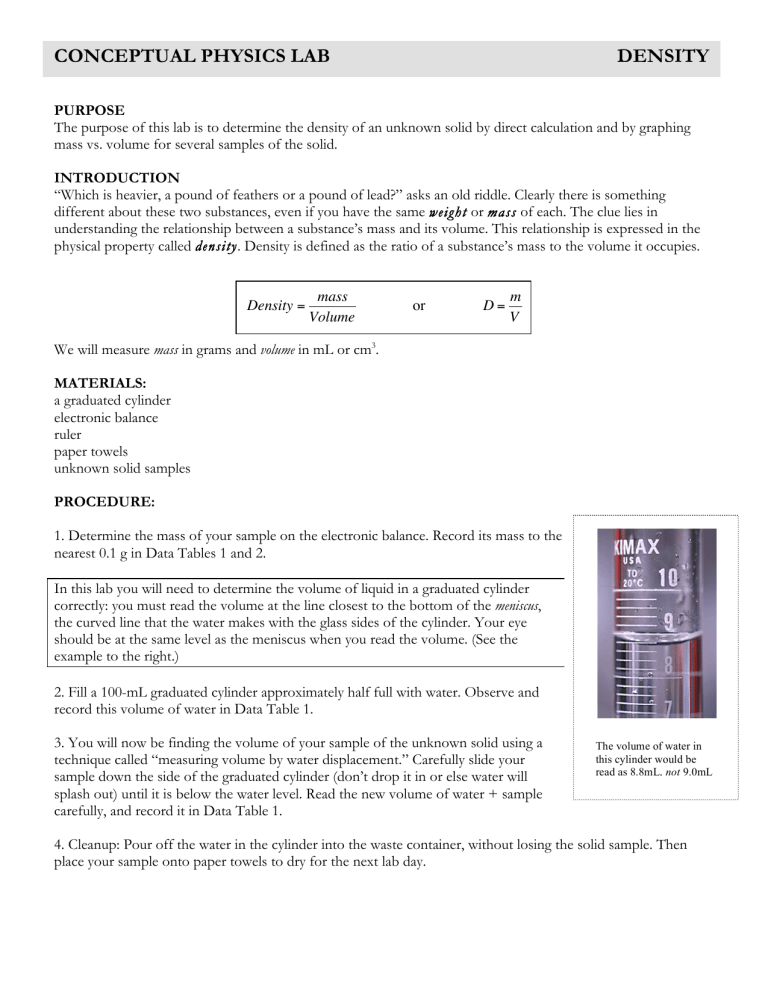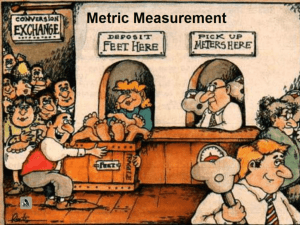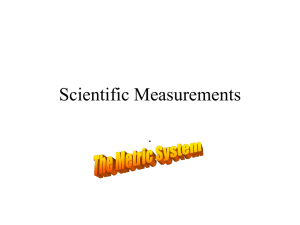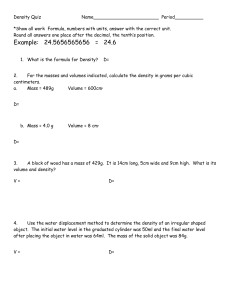
CONCEPTUAL PHYSICS LAB DENSITY PURPOSE The purpose of this lab is to determine the density of an unknown solid by direct calculation and by graphing mass vs. volume for several samples of the solid. INTRODUCTION “Which is heavier, a pound of feathers or a pound of lead?” asks an old riddle. Clearly there is something different about these two substances, even if you have the same weight or mass of each. The clue lies in understanding the relationship between a substance’s mass and its volume. This relationship is expressed in the physical property called density. Density is defined as the ratio of a substance’s mass to the volume it occupies. Density = mass Volume or D= m V We will measure mass in grams and volume in mL or cm3. € MATERIALS: a graduated cylinder electronic balance ruler paper towels unknown solid samples PROCEDURE: 1. Determine the mass of your sample on the electronic balance. Record its mass to the nearest 0.1 g in Data Tables 1 and 2. In this lab you will need to determine the volume of liquid in a graduated cylinder correctly: you must read the volume at the line closest to the bottom of the meniscus, the curved line that the water makes with the glass sides of the cylinder. Your eye should be at the same level as the meniscus when you read the volume. (See the example to the right.) 2. Fill a 100-mL graduated cylinder approximately half full with water. Observe and record this volume of water in Data Table 1. 3. You will now be finding the volume of your sample of the unknown solid using a technique called “measuring volume by water displacement.” Carefully slide your sample down the side of the graduated cylinder (don’t drop it in or else water will splash out) until it is below the water level. Read the new volume of water + sample carefully, and record it in Data Table 1. The volume of water in this cylinder would be read as 8.8mL, not 9.0mL 4. Cleanup: Pour off the water in the cylinder into the waste container, without losing the solid sample. Then place your sample onto paper towels to dry for the next lab day. CONCEPTUAL PHYSICS LAB DENSITY DATA TABLE 1: Individual data Mass of dry sample (g) Volume of water alone (mL) Volume of water + solid sample (mL) 5. Calculate the volume of your sample. Show your work and label your answer with the correct units. Record this volume for your sample in Data Table 2. Volume = ____________ Now put your data for mass and volume of your sample on the board, and be sure to copy all other groups’ data from the board into Data Table 2. This class data will be used for your analysis. 6. Calculate the density of your sample. Show your work and label your answer with the correct units. Density = _______________ CONCEPTUAL PHYSICS LAB DENSITY DATA TABLE 2: Class data for Mass and Volume Complete this table with data from the board. Student Names Mass of sample (g) Volume of sample (mL) CONCEPTUAL PHYSICS LAB DENSITY DATA ANALYSIS: 1. Using the class data from Data Table 2, plot a graph of mass vs. volume. Use a full page of graph paper (on the back of this page), and plot mass on the vertical axis and volume on the horizontal axis. Make sure your scale is large enough so that your graph takes up most of the paper. The horizontal and vertical scales need not be the same. (For example, you might use four or five spaces to represent one mL on the horizontal axis, while each vertical space might represent one or two grams.) Now plot the points. You do not need to label every point. You should, however, add an appropriate title to your graph. 2. Now use your ruler to draw a “best fit” straight line through all the points. Before you do, discuss with your partner whether or not the line should go through (0,0). (What would be the mass of something that had zero volume?) 3. Determine the slope of the line on the graph, using techniques you have learned in math class (rise over run should ring a bell). Show your work here, including all units. 4. What are the units of your slope? _________ What do these units represent? __________ 5. Looking at your graph, what does this experiment demonstrate about the density of a solid? Does it depend on the size of the sample, or is it the same for all samples of the same substance? Explain. 6. The actual density of the material you were given is _______________ (get this value from your teacher). Calculate a percent error to see how far off your class data was from the actual density. %error = € accepted value − experimentalvalue ×100 accepted value CONCEPTUAL PHYSICS LAB DENSITY 7. What are the advantages of using water displacement to determine the volume of the sample? What is another way you could have determined the volume of your sample? CONCEPTUAL PHYSICS LAB DENSITY





